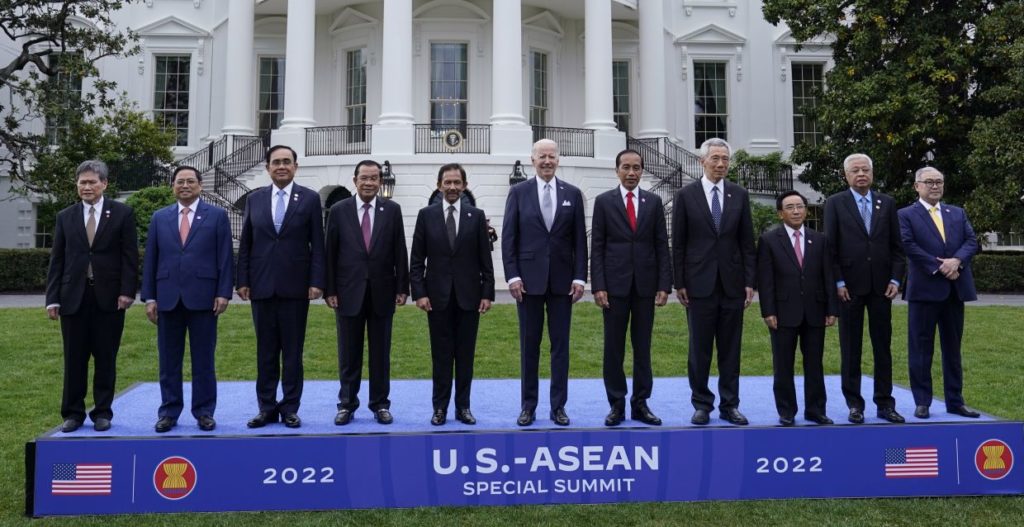
It Is Not Abandonment But Rather Strategic Positioning…
The ‘pivot to Asia’, first introduced by President Barack Obama, has always been at the mercy of other emergencies on the American agenda. A war in Afghanistan, covid-19, Iran and a war in Ukraine are a few examples.
The simplified thinking has been to reallocate resources from the Middle East to Asia, the world’s most populous continent, which is increasingly becoming the epicenter of global affairs. The shortcoming in this strategy, however, is the U.S. dependence on the Middle East for energy, as illustrated by President Joe Biden’s recent trip to the region and his pitch for increased oil production from Saudi Arabia amid the current price environment.
Despite this shortcoming, the current dynamics in the Middle East are creating an opportune time for U.S. leadership to strategically shift priorities on the global stage, especially as the U.S. is not entangled in any war (this statement reluctantly ignoring the U.S. involvement in Ukraine).
Dynamic #1: Abraham Accords and Security
The Abraham Accords, which normalized relations between Israel and Bahrain and the UAE, effectively formalized the engagement between the three states that has long persisted informally behind the scenes. Critics continue to label the Abraham Accords as a vanity project of former President Donald Trump as the Abraham Accords do not necessarily solve the serious economic, political, and social problems that currently trouble many regional countries.
Supporters of the Abraham Accords nevertheless will quickly retort that advocates for the change in policy were not focused on creating European Union style relations between the three states. Rather, supporters rightfully emphasize the burgeoning Arab version of the NATO alliance, which Israel’s defense minister Benny Gantz gave credence to last month with an official confirmation of the Middle East Strategic Alliance to Israel’s parliament. According to Gantz, the alliance includes the Middle East Air Defense (MEAD) system that “is already operating, and has already led to thwarting Iranian attempts.”
MEAD participants include countries, such as Saudi Arabia, who do not have ‘open’ relations with Israel and who may prefer to avoid public disclosure of such a relationship. Other participants could include Kuwait and Jordan, who due to their electoral systems will, like Saudi Arabia, want to avoid any appearance of cozying up to Israel…. that said, irrespective of public acknowledgement (or not) of relations, MEAD is a manifestation of the changing security alliances and dynamics in the region.
Dynamic #2: Iran as the Common Enemy
U.S. efforts to re-broker the Iran nuclear deal become increasingly challenging as the calendar approaches November midterm elections and the potential for a Republican-controlled Congress turns the discussions into a game of political football. Accordingly, the greater Israeli-Arab cooperation and MEAD represent a strategic counterbalance for countries, in particular the UAE and Saudi Arabia, which both view Iran as growing threat to peace and remain very concerned about the potential of Iran with nuclear weapon capability…Let us not forget that Russia’s nuclear weapons have provided President Vladimir Putin with sufficient cover against a direct NATO counterattack for Russia’s war in Ukraine.
Critics of a potential nuclear deal argue that a successful renewal creates another problematic scenario where Iran receives a lot of money from the U.S. (and its allies) and uses that money to fund its proxies, such as those in Iraq and Yemen, with weapons and other resources which further destabilizes the region. This worry is further underscored by reports that the Biden administration would consider the removal of the Iranian Revolutionary Guard Corps (IRGC) from the U.S. terror list as part of a new agreement. It is this type of ‘backfiring’ scenario that both worried the Trump administration and incentivized Israeli-Arab cooperation. By and large, the uncertainty of U.S. regional presence and policy (in particular, Iran nuclear deal or no Iran nuclear deal) is a significant driving force for the strengthening of an Israeli-Arab alliance.
Dynamic #3: Saudi and UAE Political and Economic Strength
Underpinning a lot of the change in the region is also the economic and political strength of Saudi Arabia and the UAE. An oil boom is filling government coffers and funding political and economic ambitions for both countries, which aligns their interests (along with other members of OPEC) on controlling oil production and prices. Both countries are also run by strong royal personalities—President Mohammed bin Zayed in the UAE and Crown Prince Mohammed bin Salman in Saudi Arabia—who agree on more (i.e., regional security and Iran, OPEC controls, and regional economics) than they disagree (i.e., Yemen War)…the alliance between the two heavyweights is as equally important as the increased engagement with Israel.
Dynamic #4: Weakened Asian States
President Gotabaya Rajapaksa (or Gota as he is known locally) recently emailed his resignation from outside the country as angry Sri Lankans ransacked the presidential palace in Colombo. The scene was a disturbing fall from grace for the governing party that won a landslide victory in Sri Lanka’s parliamentary elections in August 2020. The win was viewed then as a redemption victory for the Rajapaksa family after Gota’s brother Mahinda Rajapaksa lost the presidential election in 2015.
Most observers, however, back then understood the uphill economic climb facing the country as covid-19 and the lack of a vaccine both obliterated tourism revenue and the Sri Lankan government coffers. Two years later, Sri Lanka (like many other countries in Asia) has sadly not fully opened nor recovered from the effects of covid-19.
False starts with opening borders for tourism and new covid-19 variants continues to thwart regional economies dependent on tourism. Economists are already watching Nepal as tourism has not recovered to previous levels and inflation coupled with a struggle to import food and fuel undercuts the economy. A similar narrative (to a lesser degree) is emerging in Thailand.
The local protests and weakened political infrastructure coupled with the economic uncertainty creates regional risk. China has normally provided substantive financial and political support but China is also in a weakened position…
Dynamic#5: China’s Challenged Economy
China’s announcement that its economy grew by only 0.4% in the second quarter highlights the challenges of “zero-covid” efforts. Virus controls shut down Shanghai, which is home to the world’s busiest port, and other industrial centers dating back to late March this year. Some factories and offices reopened two months later in May, but economic activity may not return to normal levels for weeks or months. June numbers suggest industrial and retail will rebound, with both up 3.9% and 3.1% respectively compared to the June 2021.
Despite the June optimism, an economic rebound in China will be slow with global inflation and other economic challenges at home and globally. The country is also confronting a property crisis, which is creating volatility in the banking system, while regulatory crackdowns on certain sectors, in particular tech, has disrupted investment and growth. For regional partners, a lack of Chinese travelers (limited by covid-19 restrictions for Chinese citizens) and diminished Chinese trade and business weakens the economic security blanket expected by many regional parties from China.
Pivoting to Asia at the Right Time…But How?
The U.S. pivot to Asia is timely and strategic…though questions remain on how the U.S. will make the pivot. Strategic economic alliances, such as the Indo-Pacific Economic Framework (IPEF), are broadly aligned with the U.S. expanding its economic participation and leadership in Asia. However, these types of alliances also demonstrate the challenges with U.S. economic policy in the region.
IPEF is not a free trade deal as new free trade deals are not finding substantive support from Democrats or Republicans…supporting free trade deals sadly is not a winning political strategy in today’s environment as illustrated by the death of the Trans-Pacific Partnership (TPP). Yet, it is trade and business that many Asian countries require as they recover from the economic effects of covid-19. The lack of political will or support to make new free trade deals in Asia may ultimately undermine U.S. ability to assume a robust leadership and economic position in the region.
Furthermore, IPEF (as well as TPP) do not target some of the region’s weaker economies, such as Sri Lanka and Nepal. The U.S. focus on major Asian partners, such as Australia, Japan and South Korea, makes sense, considering the group’s collective view of China as a threat and broad desire to create a counterbalance to China. But a sustained regional influence will be dependent on the U.S.’s ability to align with smaller countries through economic support — i.e., trade deals or infrastructure investment.
The U.S. could take a page out of the Chinese playbook in Latin America where the Chinese are providing significant debt financing for infrastructure projects. Most of the countries are participants in the Belt and Road Initiative with many countries also planning to use Huawei equipment (or other Chinese-made equipment) for their 5G networks and related tech infrastructure. Can the U.S. provide similar funding and support to Asian countries? Can the U.S. provide technical support to the region? It is these types of questions that U.S. leaders will have to answer.
Less resources are required in the Middle East without the U.S. involved in any war and the expanding strength of regional alliances. That said, to get to the current state of the Middle East was not inexpensive nor was it quick, thus the U.S. should not expect a quick process in finding its path or footing in Asia. Lastly, China (and Russia) are focused on the Middle East — China as the second largest energy consumer behind the U.S. and Russia as an oil producer — thus U.S. efforts in Asia are not necessarily independent of U.S. interests in the Middle East.
